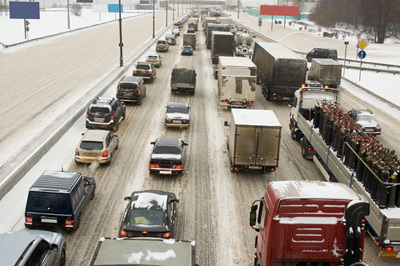|
Holiday Driving Hazards
The holiday season is almost here and across the country people are pulling out their decorations, planning parties and searching for the perfect gift for everyone on their list. For many, that all adds up to the most wonderful time of the year. For drivers, however, the holidays bring additional hazards to look out for including increased travel, sharing the road with intoxicated drivers, drivers not accustomed to long trips and battling poor driving conditions.

Increased Travel
Thanksgiving, Christmas and New Year’s Day are among the busiest travel periods, with many people opting to drive to their destinations. Last year, the American Auto Association (AAA) estimated that 40 million people drove to their destinations for Thanksgiving and nearly 86 million were on the road for the year-end holidays. With more people on the road, drivers should take extra precautions to prevent collisions. Congested traffic may cause other vehicles to tailgate and end up in a driver’s blind spot. Drivers should always be aware of their blind spots and use caution when switching lanes in heavy traffic. They should also signal their actions, such as changing lanes or turning, well in advance so other drivers have enough time to react.
Intoxicated Drivers
Holiday celebrations include food, fun and, in some cases, alcohol. With travel in general increasing, the number of people driving under the influence will also increase during the holidays. According to the National Traffic Highway Safety Administration (NTHSA), nearly 11,000 people were killed in 2009 in alcohol-induced driving crashes. The highest risk of drunk driving crashes is between midnight and 3 a.m., with the next worst times being 9 p.m. to midnight and 3 a.m. to 6 a.m. Warn drivers to watch out for intoxicated drivers who often veer into other lanes, make extremely wide turns, drive too slow or too fast, and may hit other cars or objects. Your drivers should keep their distance from suspected intoxicated drivers and call 911 to report them.
Poor Driving Conditions
Some people wish for a winter wonderland during the holidays, but inclement weather creates unique challenges for drivers and increases opportunities for accidents. During pre-trip checks, drivers should make sure they have plenty of windshield washer fluid and that wiper blades are in good condition. Cracked or broken wiper blades can hinder drivers’ view.
Drivers also need to examine the tread on their tires and, if needed, add tire chains to increase traction. On the road, drivers should brake gently in icy conditions and avoid jerky steering movements. They should also increase their following distance, drive slower and look far ahead to give them as much reaction time as possible. Drivers lose control of their vehicles because they too often overestimate their personal driving ability or the ability of their vehicles to maintain proper traction. In extreme weather, drivers should find a safe place to pull off the road and wait out the conditions.
Keep your drivers safe this season by educating them on these holiday driving hazards. For additional safety training resources, please refer to the Resource Library.
<< back |
|
